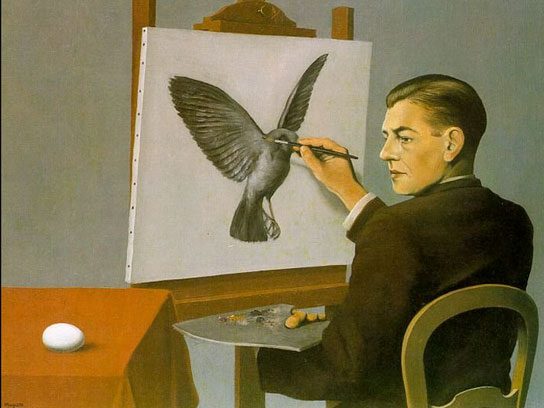Laugh along with some of art history's funniest paintings ever

Are These the World’s 7 Funniest Paintings?


La Clairvoyance, René Magritte, 1936
The funny, far-out visions of surrealists like René Magritte and Salvador Dalí influenced decades of graphic humor, from Monty Python to classic ’90s cartoons and beyond. In this self-portrait, Magritte demonstrates his wit and forward-thinking by studying an egg to paint a bird, and it ranks among the funniest paintings of its category. One might say the egg’s future is much more interesting than its present.

The Flatterers, Pieter Brueghel the Younger, 1592
Pieter Brueghel the Elder was known as “Peasant Brueghel” for all his chaotic scenes of lower-class life in the Netherlands; his son, Pieter Brueghel the Younger, was known as “Hell Brueghel” for all his depictions of, well, bleaker subjects. In The Flatterers, Hell Brueghel takes a break from the flames to show off his dark wit, and in the process coins a timeless visual metaphor for suck-ups. It’s a funny painting in the driest sense, and proof that Hell had a big sense of humor.

The Experts, Alexandre-Gabriel Decamps, 1837
When the French Academy of Painting rejected several works by Decamps for being too experimental, he responded with this loving portrait. The Experts depicts several serious art critics in chimpanzee glory, overanalyzing a baroque landscape. This style, in which monkeys participate in human behavior, is called a singerie, and it occurs in art back to ancient Egypt.

Parody of the Fauve Painters, Robert W. Chanler, 1913
When the 1913 Armory Show brought work by Picasso, Duchamp and Matisse to New York for their first major show, not all viewers appreciated their style. Robert Chanler, a local artist and hobnobber, took particular offense to Matisse’s bold, wildly painted nudes and created Parody of the Fauve Painters, a singerie that casts Matisse as head chimp, surrounded by adoring students and controversial canvases. Subtle, no. But at least Chanler took his time to dig at Matisse with style.

Youth Making a Face, Adriaen Brouwer, 1632–1635
Dutch Golden Age artists loved kinetic scenes of daily life, some idealized, others … not so much. The crude, mocking boy in this mugshot by Adriaen Brouwer may stand in for a crude, mocking painter. Brouwer, notorious for his unkempt appearance, once bought a fancy suit for a wedding, showed up for dinner and immediately started smearing pies all over his clothes.
“Since it was the suit, rather than the man wearing it, that had been invited,” Brouwer announced, as cited by the National Gallery of Art, “it deserves to feast on the food.”

Escaping Criticism, Pere Borrell del Caso, 1874
Preempting the surrealists, Spain’s Pere Borrell del Caso blurred the lines between image and reality with this bug-eyed boy’s desperate escape from gallery prison. Such a convincing trompe-l’oeil (that’s art-speak for “optical illusion“) may have baffled as many 19th-century viewers as it amused, although modern internet users probably understand the need to flee from trolls.

L.H.O.O.Q., Marcel Duchamp, 1919
Famous for once submitting a store-bought urinal to an art exhibition, prankster and painter Marcel Duchamp made waves with his satiric “readymades,” or pre-manufactured objects slightly modified to take on new meaning. In L.H.O.O.Q., Duchamp jokes about Renaissance values by penciling a Van Dyke moustache onto Da Vinci’s masterpiece.
As for the title? That’s a joke too: Spoken aloud, the letters mimic the French phrase “Elle a chaud au cul,” which literally translates to “She is hot in the behind.” It’s one of the funniest paintings in modern art, as long as you’re in on the context!
Why trust us
Reader’s Digest has been telling jokes for more than 100 years, curated and reviewed over the last 20 years by Senior Features Editor Andy Simmons, a humor editor formerly of National Lampoon and the author of Now That’s Funny. We’ve earned prestigious ASME awards for our humor—including comical quips, pranks, puns, cartoons, one-liners, knock-knock jokes, riddles, memes, tweets and stories in laugh-out-loud magazine columns such as “Life in These United States,” “All in a Day’s Work,” “Laughter, the Best Medicine” and “Humor in Uniform,” as well as online collections such as short jokes, dad jokes and bad jokes so bad, they’re great. You can find a century of humor in our 2022 compendium, Reader’s Digest: Laughter, the Best Medicine. Read more about our team, our contributors and our editorial policies.
Sources:
- René Magritte: “La Clairvoyance, 1936 by Rene Magritte”
- Christie’s: “A guide to the artists of the Brueghel dynasty”
- Metropolitan Museum of Art: “The Experts”
- Antiques and the Arts: “Woodstock Exhibition Highlights Impact of 1913 Armory Show, Modernism”
- National Gallery of Art: “Youth Making a Face”
- BBC: “The Painting That Tricks the Eye”



















